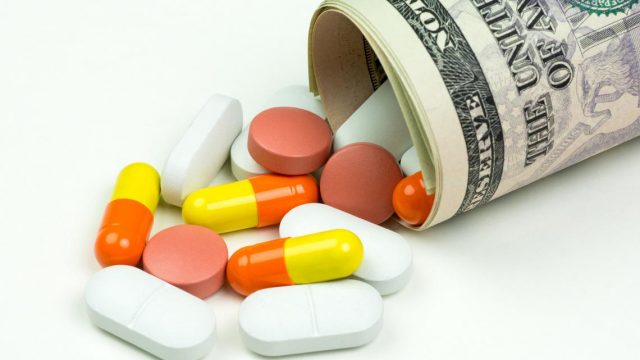Senators Cramer and Grassley: How Congress Can Fix High Drug Prices

This guest post was submitted by Republican Senators Chuck Grassley and Kevin Cramer. Grassley, Iowa’s senior U.S. senator, is chairman of the Senate Finance Committee. Cramer is North Dakota’s junior U.S. senator.
Washington is consumed with wall-to-wall coverage of impeachment, Ukraine, and transcripts. Every question we receive from the D.C. press corps is about that. But do you know who isn’t obsessed with this? Our constituents.
Every day, we hear from people across North Dakota and Iowa. Most of them are not talking to us about impeachment. They are coming to us because they worry about being able to afford the medications they need to live. They face heartbreaking calculations, trying to figure out if they can pick up their prescriptions and still afford to put food on the table or pay for their housing.
This is reality for people living outside the Washington bubble. It’s the reality for many of our constituents and people all across the country. It’s the reality we’re determined to fix through bipartisan and thoughtful legislation.
[mks_pullquote align=”left” width=”300″ size=”24″ bg_color=”#ffffff” txt_color=”#000000″]The day-to-day political dramas that shroud “Beltway Insiders” don’t represent the wants and needs of most Americans.[/mks_pullquote]
There are a lot of factors that keep the cost of prescription drugs high. One of them is pharmacy benefit managers or PBMs. These middlemen in the drug supply chain act as a go-between for pharmacies and insurers. Under Medicare Part D, PBMs negotiate the price of prescription drugs. In a perfect world, they would use the savings to lower the amount the patient pays at the pharmacy counter; unfortunately, that rarely happens.
Prescription drug middlemen, as well as drug manufacturers, too often respond to the current incentives in the system by putting their financial gain ahead of patients. A pointed example is the egregious increase in the cost of insulin. Though this drug has been available for nearly a century, its list price has recently skyrocketed. In Medicare alone, out-of-pocket costs for insulin have more than quadrupled since 2007. It’s been estimated that the price of a 40-day supply of this diabetes treatment rose from $344 in 2012 to more than $660 just four years later.
Though manufacturers set the list price for insulin, PBMs play a critical role in pricing as the primary negotiators. The American Diabetes Association found that as PBMs have secured increased rebates as a percentage of the list price, the heightened rebates have contributed to the higher cost of insulin for too many patients. Patients who have to pay out-of-pocket or pay a percentage of the list price instead of a lower flat co-payment can face financial challenges that can have devastating consequences. Earlier this year, the Senate Finance Committee held a hearing on drug pricing. At that hearing, one witness testified that her son, worried about the financial burden his monthly $1,700 insulin prescription was putting on his parents, began rationing his treatments. Tragically, that can have life-threatening consequences.
Bipartisan legislation, on top of aggressive oversight of insulin manufacturers and PBMs, are the steps we’ve already taken to help bring down costs of insulin and other prescription drugs. But other factors contribute to high prices at the pharmacy counter.
Other PBM practices also keep drug prices high so that patients pay more at the pharmacy counter. PBMs use direct and indirect remuneration fees, also called “clawback” fees, that pharmacies must pay back months after a prescription is filled. This practice not only puts a strain on pharmacies’ ability to serve their communities, it requires patients to pay based on an amount that is higher than the true cost of the drug. Another way is through spread-pricing. PBMs buy drugs from wholesalers at one price and sell them to pharmacies at a much higher price. The discrepancy between prices is often significant, particularly for generics. The inflated prices are good for PBMs, but bad for patients and taxpayers.
Increased transparency in the drug pricing system is critical to lowering costs for patients and taxpayers. That’s why we’ve been working on legislation that shines a light on manipulative practices by drug makers and PBMs, including the Prescription Drug Pricing Reduction Act.
This legislation not only increases transparency into the opaque practices of PBMs but also addresses the lack of transparency in manufacturer drug pricing decisions. Further, it improves incentives to increase negotiation between prescription drug plans and manufacturers in order to help reduce costs at the front end of the process and provide true savings to patients at the pharmacy counter.
The Congressional Budget Office estimates that our bill would save taxpayers more than $100 billion — including $90 billion in Medicare and more than $15 billion in Medicaid. Medicare beneficiaries would also save $25 billion in out-of-pocket costs and $6 billion in premiums. Americans in the commercial market would also see savings due to a provision in the bill that would reduce Medicare costs for prescription drug benefits also offered by commercial insurance plans.
The day-to-day political dramas that shroud “Beltway Insiders” don’t represent the wants and needs of most Americans. It’s the kitchen table issues, such as the high cost of prescription drugs, that folks in North Dakota, Iowa, and other states want and need solutions for. With leaders on both sides of the aisle recognizing this problem, we have an opportunity to pass meaningful, bipartisan legislation to help those we serve. While no legislation is ever perfect, we urge our colleagues to join our efforts and work with us to pass real reforms.




